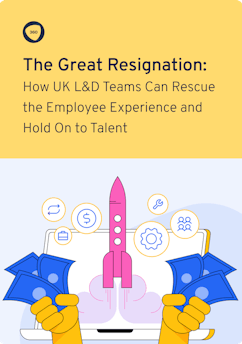Women Are Shouldering the Burnout Burden
As part of our ongoing series examining the Great Resignation, we’ve surveyed 784 Brits to find out more about their relationship with work, get to the bottom of the causes of employee quit rates, and understand what it means for L&D teams. Read our third article below or start from the beginning here.

This week, we’re turning our attention to burnout, one of the main causes of people quitting their jobs. We’ll explore who’s most at risk, and look at the part L&D teams should play in providing adequate support to prevent employees from resigning due to work-related stress.

The impact of the COVID-19 pandemic on mental health
The COVID-19 pandemic has caused the lines between work and home life to become increasingly blurred. As a result, employees say they’re working longer hours–and some report they’re struggling to manage their job and family responsibilities. Even before the pandemic, the World Health Organisation (WHO) was calling burnout the occupational phenomenon, suggesting COVID-19 has only exacerbated the issue further.

In a survey conducted by Mental Health UK, 1 in 5 workers feels they are unable to manage pressure and stress levels. Furthermore, three-quarters of UK employees experienced burnout in 2020, up from a global average of 71% the previous year.
As the surge of workers feeling the symptoms of burnout continues, it’s clear work-related stress has become one of the main drivers of the Great Resignation—and our own survey confirms this.
1 in 5 workers feels they are unable to manage pressure and stress levels.
Of the 349 employees we surveyed who said they had recently quit or were thinking about quitting their jobs, 23% cited “burnout/my job was too stressful” as the top reason for leaving. So, who’s really feeling the burn?
Who’s at risk?
Gender plays a significant role when it comes to employees experiencing burnout. One report finds that nearly 1 in 4 working women in the UK are unable to manage pressure and stress at work, with only 44% confident that their employer has a plan in place to prevent burnout. Our survey affirms this. Of the respondents who quit their jobs due to burnout, 25% were women compared to 21% who were men.
Only 44% of women are confident that their employer has a plan in place to prevent burnout.
This may seem like a small difference, but considering the record numbers of people quitting their jobs right now, this points to many thousands more women in the UK experiencing a harmful level of workplace burnout.

Of the 32% of women who quit from burnout and held leadership/managerial positions, 75% said they didn’t feel their employer provided adequate manager training and support and the same percentage of people (75%) felt additional support could have helped them manage workplace stress better.
Considering that UK business frequently claim to want greater gender diversity in leadership positions, this symbolises that in reality, once women take on a leadership role, they’re left unsupported and don’t have the tools and resources they need to succeed.
It appears that support from employers is not only an issue for women who have quit their jobs, but for women who are still currently employed, too. Of the 416 women we surveyed, 50% said they found it difficult to manage their job and family responsibilities.
75% of women in leadership positions who quit from burnout said they didn’t feel their employer provided adequate manager training and support

These stats suggest that many women in the workplace are not getting the help they need—and for some, the lack of support is causing them to quit. So, what does the future hold for women who have resigned?
Internal mobility and career development
Burnout was just one of the reasons why women are leaving their jobs—unfulfilment (18%), low salaries (16%) and no obvious prospects for progression (9%) were some of the other reasons cited. So, what do women want to do instead of the job they quit?
Our survey found that just over half of women (56%) want to change their role.

This implies that women don’t want to leave the organisations they work for–they simply want to transition to a different and more fulfilling role. This is a huge opportunity for L&D teams to provide internal mobility and career development opportunities to retain women.
Unfortunately, this hasn’t been an option up until now—neither for the women nor the men polled. 36% of female respondents reported having asked about internal mobility options but none were available. A further 35% didn’t bother asking because they didn’t think their employer would give them what they wanted. Only, 27% said internal mobility wouldn’t have made them want to stay. For men, the results were 40%, 34% and 23% respectively.
A lack of career development appears to be a major issue for both women who have quit their jobs and those still currently employed. Of those still employed who said they were very unfulfilled at work or who gave a neutral answer, 45% stated there was no room for career development at their company. In contrast, the top answer for men was “my work isn’t valued.”

This suggests that for women, career development is a highly valued and a key criterion for feeling fulfilled at work. So, what can L&D teams do to recognise these issues and support women in the workplace?
What practical steps can L&D teams take to support women in the workplace?
Our findings show that burnout and a lack of career development opportunities for women are a major concern for UK employees. But L&D teams, together with HR leaders, can help by providing support in dealing with burnout and focusing on growth opportunities. Here are some key initiatives organisations can implement to support women in the workplace.
- Provide the right tools to identify, combat and prevent burnout. Set up a manager training programme for new managers, with a focus on spotting and preventing burnout. It’s important for employers to create a psychologically safe environment for in-person, hybrid and remote teams. You can check out our complete manager’s burnout prevention guide here, or take our quiz to assess your burnout score.
- Offer flexible working. Of the 50% of women who said they found it difficult to manage their job and family responsibilities, 62% said more flexible working hours would help them manage better and 45% said more flexibility with work from home policies would be welcomed. Be sure to offer these flexible working options to support and retain women in the workplace.
- Encourage internal mobility. Providing employees with growth opportunities that exist outside of their current department not only increases employee satisfaction but is a great way to keep talented people within the organisation.
This is a major opportunity for L&D teams to encourage women to make horizontal moves in the workplace, particularly as the majority (72%) of our surveyed female respondents said they didn't believe the only way to acquire new skills was to be promoted vs only 65% of men. Read how content marketing agency Animalz transitioned one of their employees, Cassie Naji into a new L&D role, and the positive impact the move had on Cassie and the business here. - Show women you’re committed to inclusion and diversity. There are many ways to heighten awareness of inclusion and diversity in the workplace. See how we at 360Learning launched a learning campaign to celebrate Women’s History Month as part of our initiatives already in the works to support women at our company.
- Focus on learning needs. It’s important for all employees to feel like their learning needs are being met. A democratised learning approach in which learners take control of their own learning will be imperative to keeping employees engaged.
Our survey also found that 56% of women preferred self-directed learning as a form of acquiring new knowledge, proving the Collaborative Learning approach is the way forward. Learn more about the methodology here. - Develop clear career pathways for everyone. Be sure to have the correct support systems in place to help employees achieve their milestones. For example, your engineering career paths might look like this.
- Promote a continuous learning culture. Embrace the learning organization model by encouraging continuous learning in the workplace. Ensure you have the right tools in place to facilitate knowledge consumption over time. This will help employees increase their performance, drive their fulfilment, and progress in their careers.
Additional resources:
- Diversity in Learning: 10 tips for Building an Inclusive L&D Culture from Visa, Qualtrics, WEX, and More
- 3 Great Ways Cisco Empowers Employees to Navigate Career Opportunities
- Welcome to the L&D Collective: Your One-Stop Shop for Insights, Expertise, and Community
- How Can Your Company Support Gender Equality in the Workplace?

Prevent burnout in your team.
By providing your contact info, you agree to receive communications from 360Learning. You can opt-out at any time. For details, refer to our Privacy Policy.


